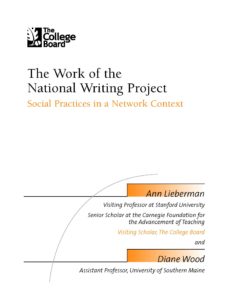The Work of the National Writing Project: Social Practices in a Network Context
Excerpt
Talking to members of the WP community, we invariably heard references to “the work” or “the model” and the importance of being faithful to it while extending it. In time, we realized that our informants tended to use the two terms interchangeably and that both connoted something essential and identifiable about the WP’s unique approach to professional development. More than a set of teaching techniques or a foundational belief system, “the work,” as a national director explained, is the “enactment of a culture” (Int., Sept. 2000). Eager to see what she meant by this, we followed the advice of site directors and observed the summer institutes, the annual invitationals inducting new WP members. As one of them explained, “It all happens there.”
Observing the institutes, we saw firsthand that “the work” is actually a pervasive and powerful set of social practices leading to the creation of strong learning communities (Lieberman and Wood, forthcoming). Three core and recurring activities initiate institute fellows into these practices: teaching demonstrations, “the author’s chair” (The term “the author’s chair” was used in the two sites we studied. Teachers actually sit in a chair in front of the audience to share their writing and get feedback from the group.) and writing groups. Rooted in the WP’s dual commitment to writing-to-learn and teachers-teaching other-teachers, these activities release professional knowledge and establish professional relationships. Each involves teachers teaching other teachers, and each requires public performance with audience feedback. In all three activities, participants alternate between giving presentations and listening to others present. In short, all three stress learning as a social phenomenon (Wenger, 1998).
Original Source: The College Board, http://www.collegeboard.com/prod_downloads/about/association/academic/annlieberman.pdf


